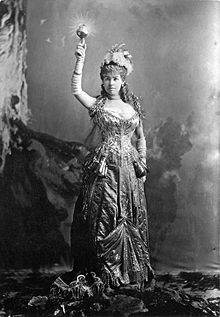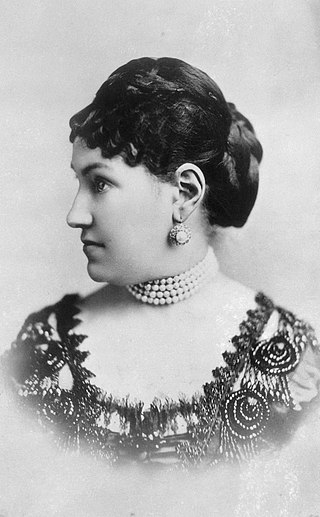
Caroline Webster "Lina" SchermerhornAstor was a prominent American socialite of the second half of the 19th century who led the Four Hundred. Famous for being referred to later in life as "the Mrs. Astor" or simply "Mrs. Astor", she was the wife of yachtsman William Backhouse Astor Jr. They had five children, including Colonel John Jacob Astor IV, who perished on the RMS Titanic. Through her marriage, she was a prominent member of the Astor family and matriarch of the male line of American Astors.

William Kissam Vanderbilt I was an American heir, businessman, philanthropist and horsebreeder. Born into the Vanderbilt family, he managed his family's railroad investments.
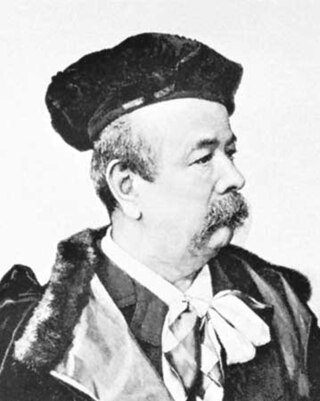
Charles Frederick Worth was an English fashion designer who founded the House of Worth, one of the foremost fashion houses of the 19th and early 20th centuries. He is considered by many fashion historians to be the father of haute couture. Worth is also credited with revolutionising the business of fashion.

William Kissam Vanderbilt II was an American motor racing enthusiast and yachtsman, and a member of the prominent Vanderbilt family.

A ball gown, ballgown or gown is a type of evening gown worn to a ball or a formal event. Most versions are cut off the shoulder with a low décolletage, exposed arms, and long bouffant styled skirts. Such gowns are typically worn with an opera-length white gloves, vintage jewelry or couture, and a stole, cape, or cloak in lieu of a coat. Where "state decorations" are to be worn, they are on a bow pinned to the chest, and married women wear a tiara if they have one. Although synthetic fabrics are now sometimes used, the most common fabrics are satin, silk, taffeta and velvet with trimmings of lace, pearls, sequins, embroidery, ruffles, ribbons, rosettes and ruching.
Mainbocher is a fashion label founded by the American couturier Main Rousseau Bocher, also known as Mainbocher. Established in 1929, the house of Mainbocher successfully operated in Paris (1929–1939), and then in New York (1940–1971).

Gladys Moore Vanderbilt, Countess Széchenyi, was an American heiress from the Vanderbilt family and wife of Hungarian Count László Széchenyi.

Marble House, a Gilded Age mansion located at 596 Bellevue Avenue in Newport, Rhode Island, was built from 1888 to 1892 as a summer cottage for Alva and William Kissam Vanderbilt and was designed by Richard Morris Hunt in the Beaux Arts style. It was unparalleled in opulence for an American house when it was completed in 1892. Its temple-front portico resembles that of the White House.
Amsale Aberra was an Ethiopian American fashion designer and entrepreneur. Her main field of design was in couture wedding gowns, and her flagship store is located on Madison Avenue in New York City. In addition to her flagship location, Amsale gowns are also sold at couture bridal boutiques such as Saks Fifth Avenue, and Neiman Marcus. She was a member of the Council of Fashion Designers of America (CFDA) and a Trustee of the Fashion Institute of Technology.

Irene is a 1940 American musical film produced and directed by Herbert Wilcox. The screenplay by Alice Duer Miller is based on the libretto of the 1919 stage musical Irene by James Montgomery, who had adapted it from his play Irene O'Dare. The score features songs with music by Harry Tierney and lyrics by Joseph McCarthy.

The William K. Vanderbilt House, also known as the Petit Chateau, was a Châteauesque mansion at 660 Fifth Avenue in Midtown Manhattan, New York City, on the northwest corner of Fifth Avenue and 52nd Street. It was across the street from the Triple Palace of William Henry Vanderbilt, which occupied the entire block between 51st and 52nd Streets on the west side of Fifth Avenue.

Alva Erskine Belmont, known as Alva Vanderbilt from 1875 to 1896, was an American multi-millionaire socialite and women's suffrage activist. She was noted for her energy, intelligence, strong opinions, and willingness to challenge convention.
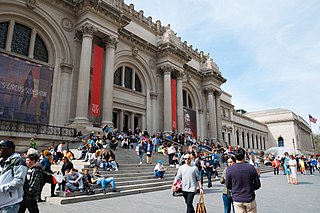
The Met Gala or Met Ball, formally called the Costume Institute Gala or the Costume Institute Benefit, is an annual fundraising gala held for the benefit of the Metropolitan Museum of Art's Costume Institute in New York City. The Met Gala is popularly regarded as the world's most prestigious and glamorous fashion event and social gathering and is known as "fashion's biggest night"; an invitation is highly sought after. Personalities who are perceived to be culturally relevant to contemporary society amongst various professional spheres, including fashion, film, television, music, theater, business, sports, social media, and politics, are invited to attend the Met Gala, organized by the fashion magazine Vogue.

The Four Hundred was a list of New York society during the Gilded Age, a group that was led by Caroline Schermerhorn Astor, the "Mrs. Astor", for many years. After her death, her role in society was filled by three women: Mamie Fish, Theresa Fair Oelrichs, and Alva Belmont, known as the "triumvirate" of American society.

Caroline Schermerhorn Astor Wilson was an American heiress, social leader, and prominent member of New York society.
American Woman: Fashioning a National Identity was an exhibit at the Metropolitan Museum of Art in New York City, New York that ran from May 5 to August 15, 2010. This exhibition explored the evolution of the modern woman's image from the 1890s to the 1940s in the United States. Taking approximately nine months to complete, the goal of the exhibition was to create a "time machine" of women's clothing from the past to present. The exhibit was the first from the Costume Institute to incorporate pieces from the Brooklyn Museum Costume collection which had recently been transferred to the Met's holdings. The exhibition, consisting of a range of women's clothing from ball gowns to cycling suits, displayed the impact of "Gibson Girls", "Screen Sirens", and "Bohemians" on American women.
John Innes Kane was an American explorer, scientist and philanthropist who was prominent in New York Society during the Gilded Age.
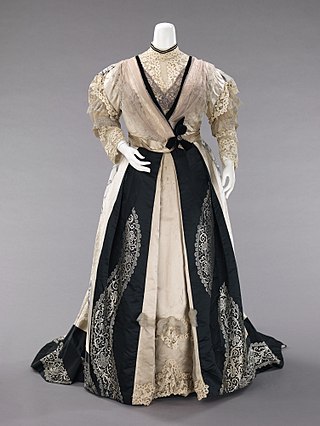
Catherine Donovan, was an Irish-American dressmaker, best remembered for her dress shop/home on Madison Avenue in New York City in the early 20th century. Her designs have been preserved and exhibited in the collections of the Metropolitan Museum of Art and the Philadelphia Museum of Art.
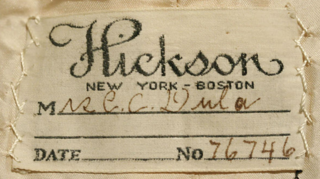
Hickson Inc. was a high-class fashion retailer, designer, and department store in New York City in the early decades of the twentieth century. The firm started as a men's tailor but evolved to be what the designer Howard Greer described as "the most elegant and expensive specialty shop on Fifth Avenue."
